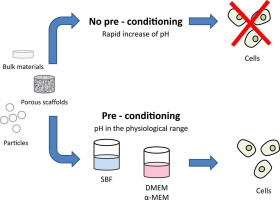Acta Biomaterialia ( IF 9.4 ) Pub Date : 2018-05-21 , DOI: 10.1016/j.actbio.2018.05.019 Francesca E. Ciraldo , Elena Boccardi , Virginia Melli , Fabian Westhauser , Aldo R. Boccaccini

|
Bioactive glasses (BGs) are being increasingly considered for biomedical applications in bone and soft tissue replacement approaches thanks to their ability to form strong bonding with tissues. However, due to their high reactivity once in contact with water-based solutions BGs rapidly exchange ions with the surrounding environment leading in most cases to an undesired increase of the pH under static in vitro conditions (due to alkaline ion “burst release”), making difficult or even impossible to perform cell culture studies. Several pre-conditioning treatments have been therefore proposed in laboratories worldwide to limit this problem. This paper presents an overview of the different strategies that have been put forward to pre-treat BG samples to tackle the pH raise issue in order to enable cell biology studies. The paper also discusses the relevant criteria that determine the selection of the optimal pre-treatment depending on the BG composition and morphology (e.g. particles, scaffolds).
Statement of Significance
Bioactive glasses (BGs), since their discovery in 1971 by L.L Hench, have been widely used for bone replacement and repair, and, more recently, they are becoming highly attractive for bone and soft tissue engineering applications. BGs have in fact the ability to form a strong bond with both hard and soft tissues once in contact with biological fluid. The enhanced interaction of BGs with the biological environment is based on their significant surface bioreactivity. This surface effect of BGs is, on the other hand, problematic for cell biology studies by standard (static) cell culture methods: an excessive bioreactivity leads in most cases to a rapid and dramatic increase of the pH of the surrounding medium, which results in cell death and makes cell culture tests on BG samples impossible. The BG research community has been aware of this for many years and numerous pre-treatments have been proposed by different groups worldwide to limit this problem. For the first time, we have reviewed in this paper the variety of surface preconditioning treatments that have been put forward over the years, we provide a summary of such pre-treatments used in laboratory practice, discussing and offering criteria that can be used for the determination of the optimal pre-treatment depending on BG composition and morphology of the sample tested (bulk, particulate, scaffolds). The information and discussion provided in this review should support best research practice when testing bioactive glasses in cell culture.
中文翻译:

解决生物活性玻璃体外生物反应过度的问题:用于细胞培养测试的预处理方法
由于生物活性玻璃(BGs)具有与组织形成牢固结合的能力,因此越来越多地被考虑用于骨骼和软组织替代方法中的生物医学应用。但是,由于它们一旦与水基溶液接触便具有很高的反应活性,BG会与周围环境迅速交换离子,这在大多数情况下会导致静态体外pH出现不希望的升高条件(由于碱性离子“爆炸释放”),使细胞培养研究变得困难甚至无法进行。因此,在全世界的实验室中已经提出了几种预处理方法来限制这个问题。本文概述了为处理BG样品而提出的不同策略,以解决pH升高问题,从而进行细胞生物学研究。本文还讨论了根据BG组成和形态(例如颗粒,支架)确定最佳预处理方法的相关标准。
重要声明
自LL Hench于1971年发现生物活性玻璃(BG)以来,它们已被广泛用于骨置换和修复,最近,它们对骨骼和软组织工程应用也变得越来越有吸引力。实际上,BG一旦与生物体液接触,便具有与硬组织和软组织形成牢固结合的能力。BG与生物环境增强的相互作用是基于其显着的表面生物反应性。另一方面,BGs的这种表面作用对于通过标准(静态)细胞培养方法进行的细胞生物学研究是有问题的:过度的生物反应性在大多数情况下会导致周围培养基的pH值急剧增加,从而导致细胞死亡,无法进行BG样品的细胞培养测试。BG研究界已经意识到这一点很多年了,世界各地的不同团体已经提出了许多预处理方法来限制这个问题。首次,我们在本文中回顾了多年来提出的各种表面预处理处理方法,我们提供了在实验室实践中使用的此类预处理方法的摘要,讨论并提供了可用于表面处理的标准。确定最佳的预处理取决于BG成分和所测试样品(散装,颗粒,支架)的形态。在细胞培养中测试生物活性玻璃时,本综述中提供的信息和讨论应支持最佳研究实践。我们在本文中回顾了多年来提出的各种表面预处理方法,我们提供了在实验室实践中使用的此类预处理方法的摘要,讨论并提供了可用于确定最佳预处理方法的标准。 -处理取决于BG组成和所测试样品(散装,颗粒,支架)的形态。在细胞培养中测试生物活性玻璃时,本综述中提供的信息和讨论应支持最佳研究实践。我们在本文中回顾了多年来提出的各种表面预处理方法,我们提供了在实验室实践中使用的此类预处理方法的摘要,讨论并提供了可用于确定最佳预处理方法的标准。 -处理取决于BG组成和所测试样品(散装,颗粒,支架)的形态。在细胞培养中测试生物活性玻璃时,本综述中提供的信息和讨论应支持最佳研究实践。讨论并提供可用于确定最佳预处理的标准,具体取决于BG组成和所测试样品(散装,颗粒,支架)的形态。在细胞培养中测试生物活性玻璃时,本综述中提供的信息和讨论应支持最佳研究实践。讨论并提供可用于确定最佳预处理的标准,具体取决于BG组成和所测试样品(散装,颗粒,支架)的形态。在细胞培养中测试生物活性玻璃时,本综述中提供的信息和讨论应支持最佳研究实践。











































 京公网安备 11010802027423号
京公网安备 11010802027423号